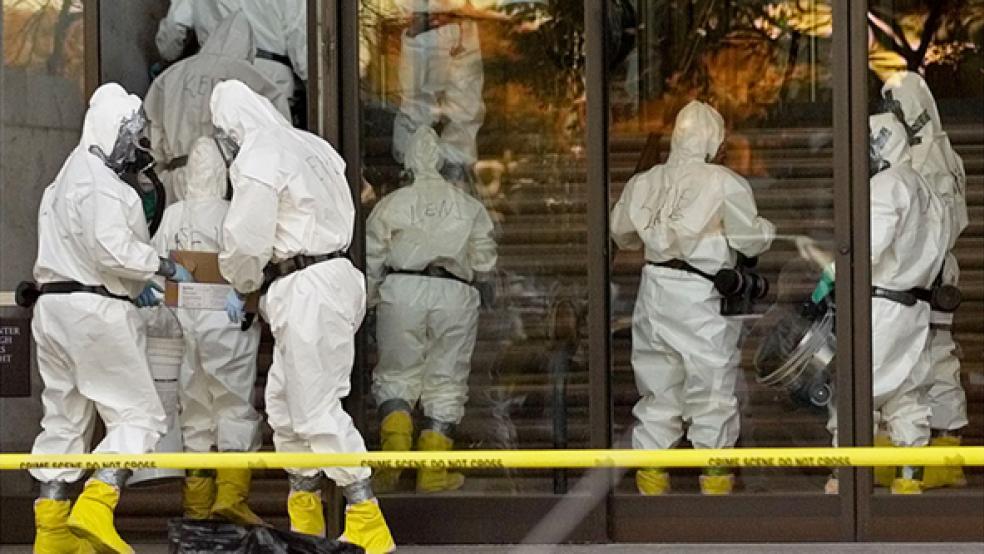Republicans and Democrats agreeing on industrial policy to save the auto industry? Unthinkable.
Republicans and Democrats agreeing on industrial policy to promote clean energy companies? Absurd.
But Republicans and Democrats agreeing on industrial policy for the pharmaceutical industry to develop drugs and vaccines to combat bioterror agents? It not only passed by unanimous consent in the Senate earlier this month, it will likely be approved by the conference committee that will soon consider the $4.5 billion Pandemic and All-Hazards Preparedness Act (PAHPA), the reauthorization of the 2006 law coordinating the nation’s decade-long effort to prepare for a terrorist biological warfare attack.
Despite the reality that the only bioterrorist attack that has ever taken place on U.S. soil (one week after 9/11) was launched by a rogue U.S. scientist who had worked in the Cold War biological weapons program and was one of the world’s few experts in weaponizing anthrax, the nation has spent an estimated $66 billion in the past decade preparing for the next assault. Tens of billions of dollars have been poured into basic science and applied research to develop vaccines and drugs to combat diseases like anthrax, smallpox (a disease that no longer occurs naturally on earth), botulism and plague.
Billions more has gone into beefing up the public health system’s ability to respond to emergency health crises. Hospitals have been paid to expand their capacity to respond to surges of patients stricken by a pandemic or a terrorist attack. These nationwide grant programs have helped build a broad base of political support for the programs.
And now, in the reauthorization bill sponsored by Sen. Richard Burr, R-N.C., Congress has earmarked $50 million for a “strategic investor” venture capital fund to invest in start-up biotechnology companies that are developing drugs and vaccines that combat bioterror pathogens. Structured as a public-private partnership outside the government, the goal is to bring more private funding into the hunt for new “countermeasure” products. It will be added to the $450 million a year the government already doles out in grants to companies through the Biomedical Advanced Research and Development Authority (BARDA) and the $2.9 billion earmarked over the next five years for procurement of new drugs and vaccines for government stockpiles.
As the votes in Congress attest (the House version of the bill also passed on a voice vote), the massive commitment to biodefense spending in the 2000s has won broad support from the nation’s research and scientific establishment. The National Institute for Allergies and Infectious Diseases (NIAID), headed since the 1980s by Anthony Fauci, receives over $1 billion a year for bioterror-oriented scientific research. The National Cancer Institute, by comparison, receives about $5 billion to look for cures for the tumors that kill over a half million Americans annually.
Officials at NIAID and legislators on Capitol Hill say the massive investment in preventing and curing diseases that rarely if ever occur naturally is providing a huge boost to the moribund U.S. effort to develop new antibiotics to fight the drug resistant bacterial strains that are causing tens of thousands of deaths annually in U.S. hospitals. “The goal of this basic research is to lay the groundwork for developing broad-spectrum antibiotics and antivirals—drugs that can prevent or treat diseases caused by multiple types of bacteria or viruses—and multi-platform technologies that potentially could be used to more efficiently develop vaccines against a variety of infectious agents,” the agency says on its website.
But some scientists complain that the anti-bioterror research agenda has detracted from research that specifically targets infectious diseases that are already killing people, both in the U.S. and in the developing world. “I’m sure other programs are reduced because of the money we’ve put into this,” said Peter Agre, director of the Johns Hopkins Malaria Research Institute and winner of the 2003 Nobel Prize in chemistry for his work on cell membrane channels. “We’re seeing scientists who have to prematurely end their careers because they can’t get grants. Is this bioterror the most important and cost-effective research being done on infectious diseases? I don’t think it is.”
However, the leaders of the Infectious Diseases Society of America, which represents the medical specialists and researchers in the field, back the program because it creates a stream of funding that otherwise wouldn’t exist. “While we understand the nation’s current fiscal pressures, we believe that greater investment in key areas is crucial to protect the American people and others from biothreats, pandemics and emerging infections,” Thomas Slama, the group’s president, wrote in a letter to House and Senate leaders last month.
Beefed up biodefense spending also gets championed by the movement to broaden the pipeline of new antibiotics being developed by the pharmaceutical industry. Their argument is the same as NIAID’s: a new drug that fights an anthrax infection could also be used to treat the drug-resistant hospital-acquired infections that kill tens of thousands of Americans a year.
“BARDA has pumped $200 million into critical developmental molecules that would either be dead or much less further along if BARDA wasn’t around,” said Brad Spellberg, a professor of medicine at the Los Angeles Biomedical Research Institute. He also consults for numerous drug companies working on new antibiotics. “The government has become a resource for companies that are not well capitalized.”


